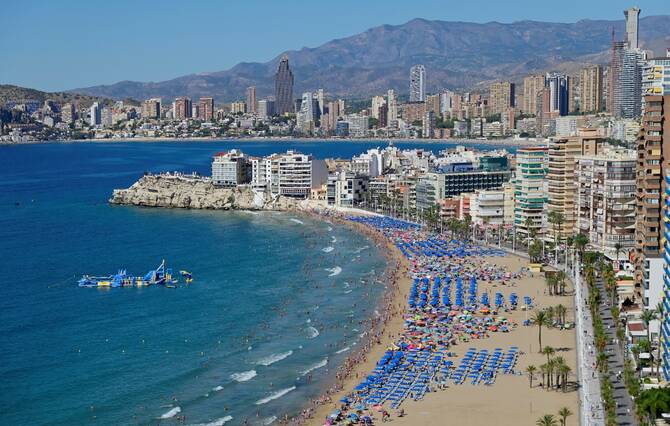
When Saudi Arabia’s Minister of Tourism Ahmed Al-Khateeb stated during this week’s UN Tourism General Assembly in Riyadh that “the cities of the future will be built for visitors, not just for residents,” he summed up in one sentence a profound shift in the way we understand global urbanism. Cities are no longer designed only for those who inhabit them, but also for those who experience them. This fits perfectly with the principles of Saudi Arabia’s Vision 2030, which places tourism and sustainable urban development at the core of its economic diversification strategy.
As someone who has witnessed, and taken part in, Spain’s transformation over recent decades from a traditional society to one of the most sophisticated tourism ecosystems in the world, I believe there are valuable lessons in how to design cities that are not only livable, but also visitable, vibrant and globally connected.
Traditionally, urban planning has focused on residents: their mobility, housing and access to services. However, the modern city is also a stage for visitors, temporary citizens who bring cultural exchange, innovation and economic opportunity. The challenge lies in creating cities that welcome them without displacing local life.
Spain’s experience offers an eloquent example. Many of its cities have evolved from local centers to global destinations where tourism has become an economic pillar without sacrificing residents’ quality of life. The secret has been integration: designing urban spaces that serve both the community and the visitor simultaneously.
A “visitor-centered city,” as envisioned by Al-Khateeb, is not one that prioritizes tourists over citizens but one that recognizes that both share the same spaces, infrastructures and aspirations: a clean, safe and enriching environment.
Tourism in Spain accounts for 13 percent of gross domestic product and, with indirect contributions, it reaches about 21 percent. Yet its true success goes far beyond numbers. It has been a driver of infrastructure modernization, cultural preservation and technological innovation. From Malaga’s smart city systems to renewable energy networks in the Balearic Islands, Spain has used tourism as a catalyst for urban progress.
In Barcelona, the transformation triggered by the 1992 Olympic Games created a new seafront that remains both a civic space for locals and an international attraction. Malaga, meanwhile, has evolved from a traditional port city into a digital and cultural hub, integrating museums, technology clusters and green mobility, to become a European benchmark in sustainable tourism.
These cities demonstrate that when tourism aligns with smart planning, it enhances urban life rather than overwhelming it. And this is precisely the model guiding Saudi Arabia’s new projects, Neom, Diriyah and AlUla, which blend innovation, hospitality and cultural authenticity.
Saudi Arabia is redefining the very concept of the city of the future. Neom aims to be a carbon-neutral metropolis powered by clean energy, where mobility, technology and nature coexist in harmony. Diriyah is shaping a model of heritage urbanism that fuses traditional Najdi architecture with contemporary comfort. And AlUla has become a global reference for how tourism can protect and enhance natural and archaeological heritage.
All these projects share a core principle with the Spanish model: the conviction that tourism and urban design can be complementary. A well-planned city attracts visitors not only for its monuments but for its way of life. Cafes, parks, public transport and cultural events are part of both the visitor’s experience and the resident’s pride.
Creating cities of the future that serve both visitors and residents requires several essential ingredients.
First, mobility. Cities must ensure smooth and sustainable movement, with accessible transport networks that minimize congestion and emissions. Spain, through the integration of high-speed rail, urban trams and pedestrian zones, has transformed how people interact with urban spaces. Saudi Arabia is already applying a similar approach through major infrastructure investments.
Second, inclusion. A city that welcomes visitors must first ensure the well-being of its residents. Affordable housing, accessible public services and community spaces are prerequisites for sustainable tourism.
Third, experience. Today’s travelers seek authenticity, not uniformity. Saudi Arabia’s tourism strategy, rooted in its cultural and natural diversity, from the historic district of Al-Balad in Jeddah to the futuristic landscapes of Neom, embodies this vision. The experience must be both local and universal, traditional and avant-garde.
Spain’s evolution offers three key lessons for Saudi Arabia’s ambitious vision of the cities of the future.
One: governance is key. Visitor-centered cities require effective coordination between the public and private sectors. In this regard, allow me to mention the General Tourism Law approved during my tenure as president of the government of the Balearic Islands, a successful example of public-private collaboration that led to a significant increase in quality, private investment and job creation, later adapted by other regions and countries.
Two: sustainability is nonnegotiable. From renewable energy to waste management, environmental responsibility is the foundation of long-term competitiveness. These same principles can guide Saudi Arabia’s ambition to become a global leader in green innovation.
Three: culture is the cornerstone. The identity of a city is its strongest brand. Spain has built its global appeal on the diversity of its regions and traditions. Saudi Arabia, with its rich history and culture, holds similar potential for international projection.
Al-Khateeb’s statement is not only a vision but a roadmap for the 21st century. Cities are no longer static spaces; they are living experiences, constantly evolving, driven by mobility, technology and culture. The visitor is no longer an outsider but a temporary participant in urban life.
Spain’s experience demonstrates that designing for visitors and residents is not a zero-sum game. On the contrary, it can be the foundation of shared prosperity. Saudi Arabia’s projects, anchored in sustainability, innovation and hospitality, are setting a new global benchmark for how countries can reimagine urban life through tourism.
The cities of the future will not only be places to live. They will be places to discover, connect and belong, even if just for a moment.
Tourism is not merely an economic sector, nor just a collection of hotels, airports, restaurants or local businesses. Tourism is, above all, a shared experience, one in which we all participate: hosts and visitors, builders and dreamers. If each of us gives our best, as only we know how, we can be truly proud of the outcome.
But this collective pride will only be possible if we work together, through public-private collaboration, to meet the standards that make a city truly balanced: as visited as it is lived and as lived as it is visited.
BY: Writer Jose Ramon Bauza, a former President of the Balearic Islands and Member of the European Parliament, is CEO of JRB Global Consulting Advisory.
Disclaimer: Views expressed by writers in this section are their own and do not necessarily reflect The Times Union‘ point of view






